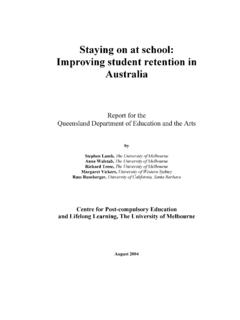Transcription of Business Correspondent Model vis-à-vis Financial Inclusion ...
1 International Journal of Scientific and Research Publications, Volume 4, Issue 1, January 2014 1. ISSN 2250-3153. Business Correspondent Model vis- -vis Financial Inclusion in India: New practice of Banking to the Poor Naveen Kolloju Doctoral Fellow, Centre for the Study of Law and Governance, Jawaharlal Nehru University, New Delhi Abstract- Financial Inclusion , access to adequate and timely formal banking services are not within their reach . 1 According credit, and other Financial services is of utmost importance for to this report, structural barriers prevent the poor from accessing socio-economic development of poor and unbanked sections. It banking facilities, thereby resulting in Financial exclusion. The enables them to alleviate their poverty levels through self- study further argues that the poor do not have savings bank employment generation and promotes them as a part of rural accounts, let alone insurance policies (Ibid).
2 Banking system. Accordingly, Indian Government is being The increasing body of literature delves into the causes for initiated various Financial measures in the banking sector, and Financial exclusion. A recurring theme in Financial exclusion is different microfinance models have been playing an active role access to institutional finance and lack of it, which not only in providing microfinance and other Financial services to the leads to income inequality but also results in slower economic rural poor. However, despite these efforts, a large number of growth. Lack of access to adequate institutional credit and other social groups remained excluded from the basic opportunities Financial services compel poor individuals and small enterprises and services provided by the formal Financial sector.
3 In these to depend on their own limited savings and earnings. This circumstances, as a part of Financial Inclusion drive, Indian restricts their choice to invest in their small Business enterprises government with the help of Reserve Bank of India (RBI), has and take advantage of growth opportunities (Ellis, 2007:82; Kunt come up with a new Model in the realm of banking sector, called and Patrick, 2009:119; World Bank, 2012: ix). Outlining the as Business Correspondent (BC) Model . This Model primarily causes of Financial exclusion, Arora points out that poor human aims at providing affordable banking facility to the hitherto development, high illiteracy and poor awareness levels prevent a unbanked population with the help of Information and large section of the population, particularly women, from Communication Technology (ICT) based application and accessing basic Financial services, which prevent them from capacity building.
4 Against this backdrop, this paper attempts to reaping the benefits of formal Financial institutions 2 (2012:179). introduce the concept of Financial Inclusion and highlights its Recent estimates show that, globally, over three billion people need. It briefly reviews the Indian banking sector and reports the lack access to basic Financial services, of which about 90 percent level of Financial exclusion in India. In the second part, it are from Africa, Asia, Latin America and the Middle East. This provides a brief understanding on Business Correspondent Model has led to a considerable demand from the developing countries and emphasizes how BC Model could significantly helps in for a more inclusive Financial system that would cater to the promoting Financial Inclusion of the hitherto excluded demands of the poor in these regions (John, Julius and Worapot, population.)
5 It concludes by emphasizing some of the operational 2009:55 and Consultative Group to Assist the Poor (CGAP), challenges in its functioning and suggests a way forward. 2012:1). The absence or the lack of formal institutional arrangements Index Terms- Business Correspondent Model , Financial to provide sustainable Financial services is believed to be one of Exclusion, Financial Inclusion , Self-help Groups. the basic causes that force the poor to increasingly turn to and depend upon the informal Financial institutions. For instance, the United Nations (2006:1) and CGAP (2012:1) reports assert that I. INTRODUCTION poor households with inadequate access to finance largely depend upon semi-formal or informal Financial providers, such as F inancial Inclusion is a global phenomenon that has gained wider currency in the development literature in contemporary times.
6 Given the magnitude of poverty in the Third World private microfinance institutions (MFIs), pawnshops and conventional moneylenders, and other rotating savings and credit economies, wherein a large segment of the population do not have access to basic Financial services, the idea of Financial 1 Here, the term reach not only signifies the availability Inclusion commonly understood as banking to all has of various Financial services, but also accessibility related issues. become conspicuous in these economies. A recent United Nations (UN) study observes that Financial Inclusion of the poor 2 Primary activities of a Financial institution is buying, is a global challenge to the achievement of the Millennium selling or holding Financial assets.
7 Financial institutions provide Development Goals (MDGs) (2006:1). This report draws various types of Financial services. Formal Financial institutions attention to a plethora of problems that are being faced by poor in such as banks, credit unions, post offices etc. largely run by accessing Financial services, and reveals the stark reality that a Government. For more details on Indian Financial system, see large number of people are not in a state of saving money as Ratti (2012), Indian Financial System & Indian Banking Sector: A Descriptive Research Study, International Journal of Scientific and Research Publications, Volume 4, Issue 1, January 2014 2. ISSN 2250-3153. associations. However, these informal Financial institutions seem II.
8 Financial EXCLUSION. to be less reliable and insecure, and also expensive than the Financial exclusion is broadly related to lack of adequate formal Financial institutions. Inadequate access to Financial access to a range of Financial services. People belonging to the services, along with the overarching dominance of the informal lower income strata are unlikely to get access to mainstream Financial providers, may impede the decision-making capability Financial services and products, and reap the benefits out of it. of the poor as they are restrained from making a rational choice Further, it prevents the poor and disadvantaged segments in while deciding the investments. taking key decisions regarding human and physical capital Given this background, Financial Inclusion is increasingly accumulation.
9 Given the above, the repercussions of Financial becoming a major focus of research, and the recent literature on exclusion could be a far-reaching, which not only destabilize the the subject focuses on emphasizing the possibilities and livelihood opportunities but also push them into a complex prospects of well-designed Financial arrangements. Scholars note phenomenon of poverty trap 4 (Mahmoud et al., 2011:5 and that better Financial services lead to the social and economic Joshi, 2011:81). Some scholars extend this argument beyond development of the rural population. With a view to economic accessibility dimension by relating Financial exclusion to income development, scholars argue, a well-functioning Financial status of the poor.
10 Income levels of an individual in any country system 3 with access to adequate institutional finance enables the determine the propensity to save from it. Underlining this view, poor to start investing money in various income-generating Joshi (2011:14) observes that majority of population in India activities and maximize the returns, and reduce their neither has savings accounts nor receives credit from formal vulnerability to the Financial risks that they encounter in their Financial institutions. They seldom make or receive payments daily lives. It helps to bring poor people into the mainstream of through formal Financial institutions. Apart from access and the economy, and allows them to contribute more actively to income dimension, Sharma (2008:3) discusses that exclusion their personal economic development.















